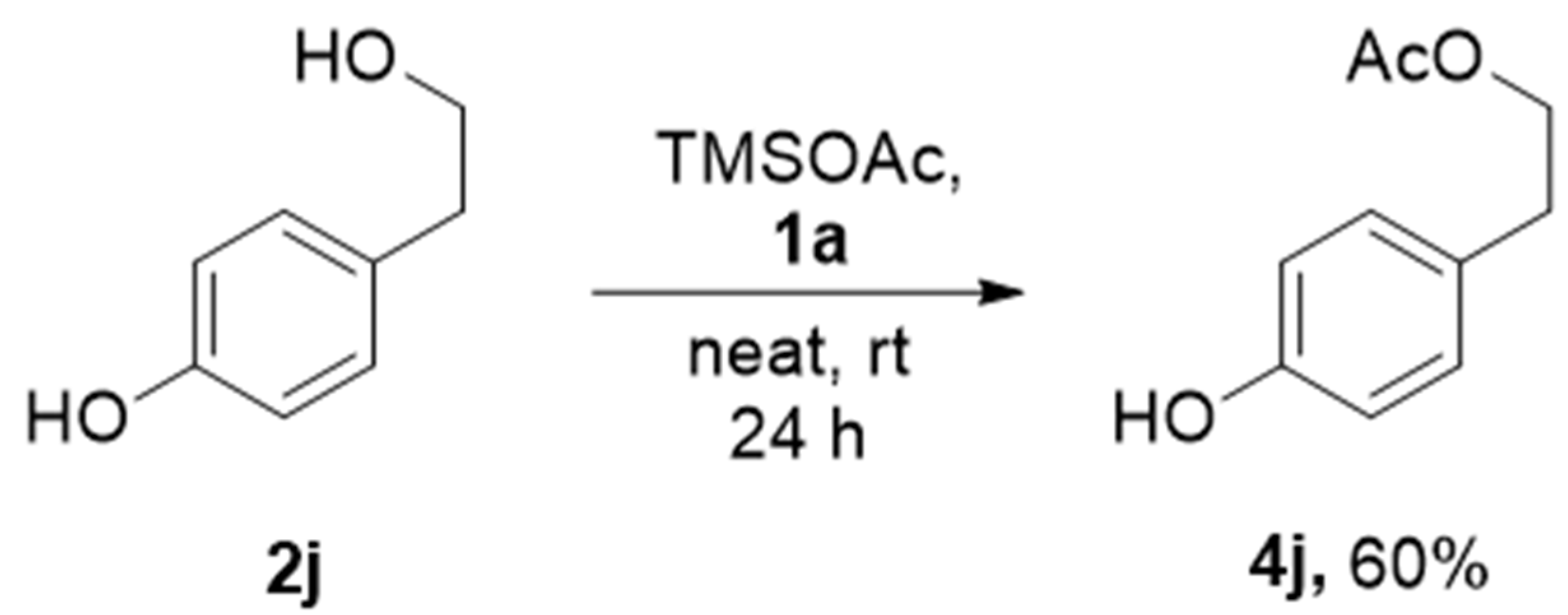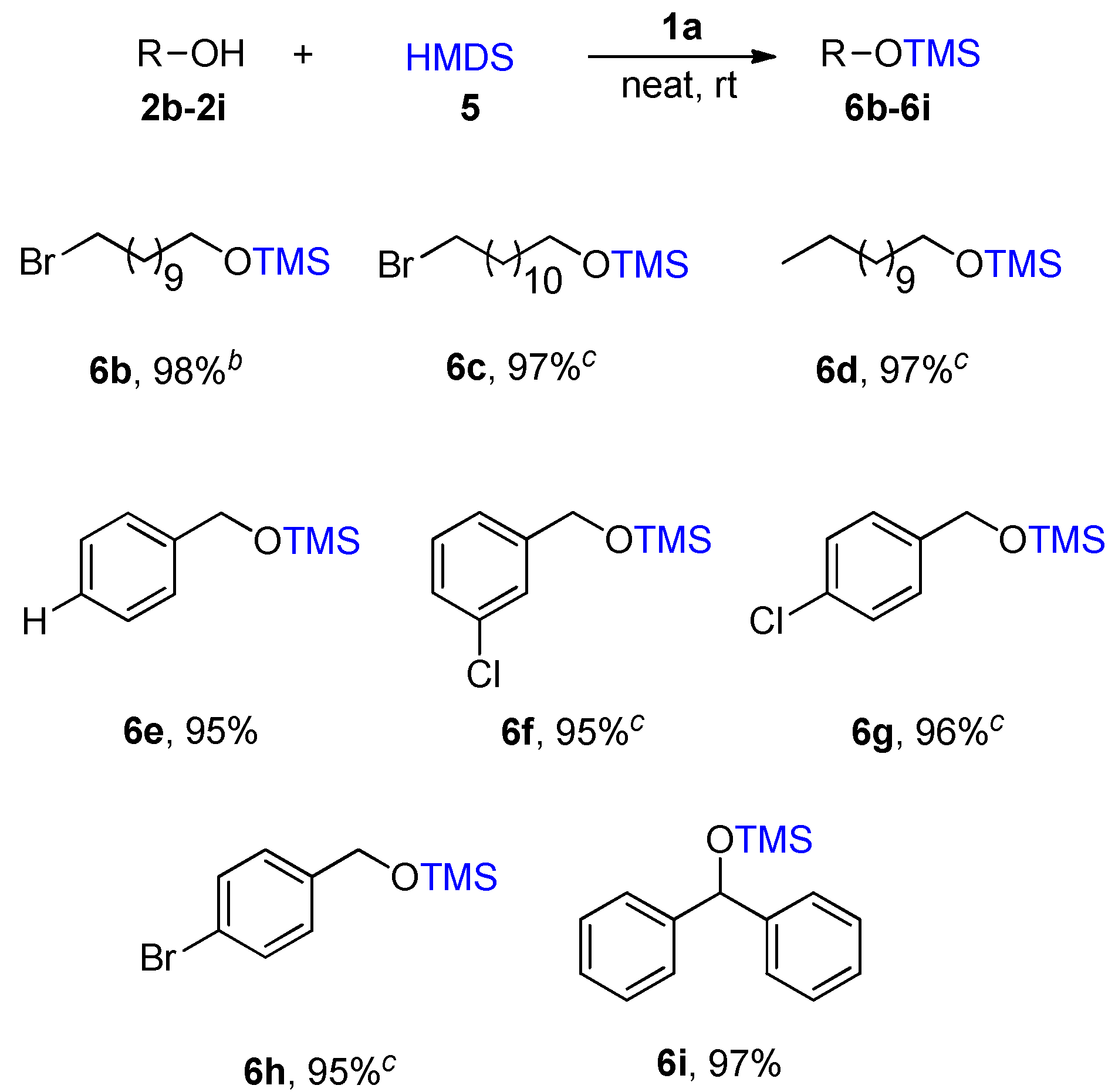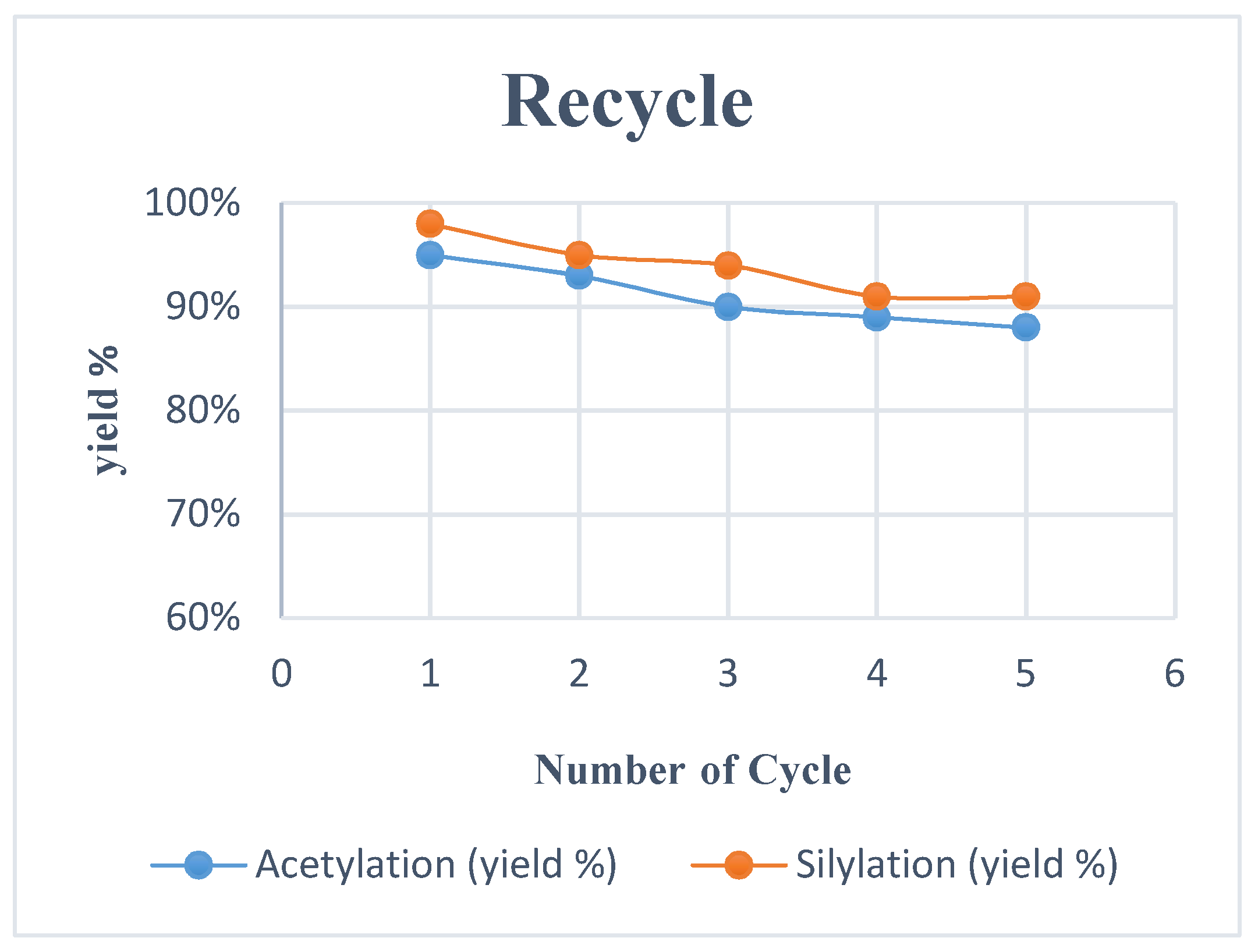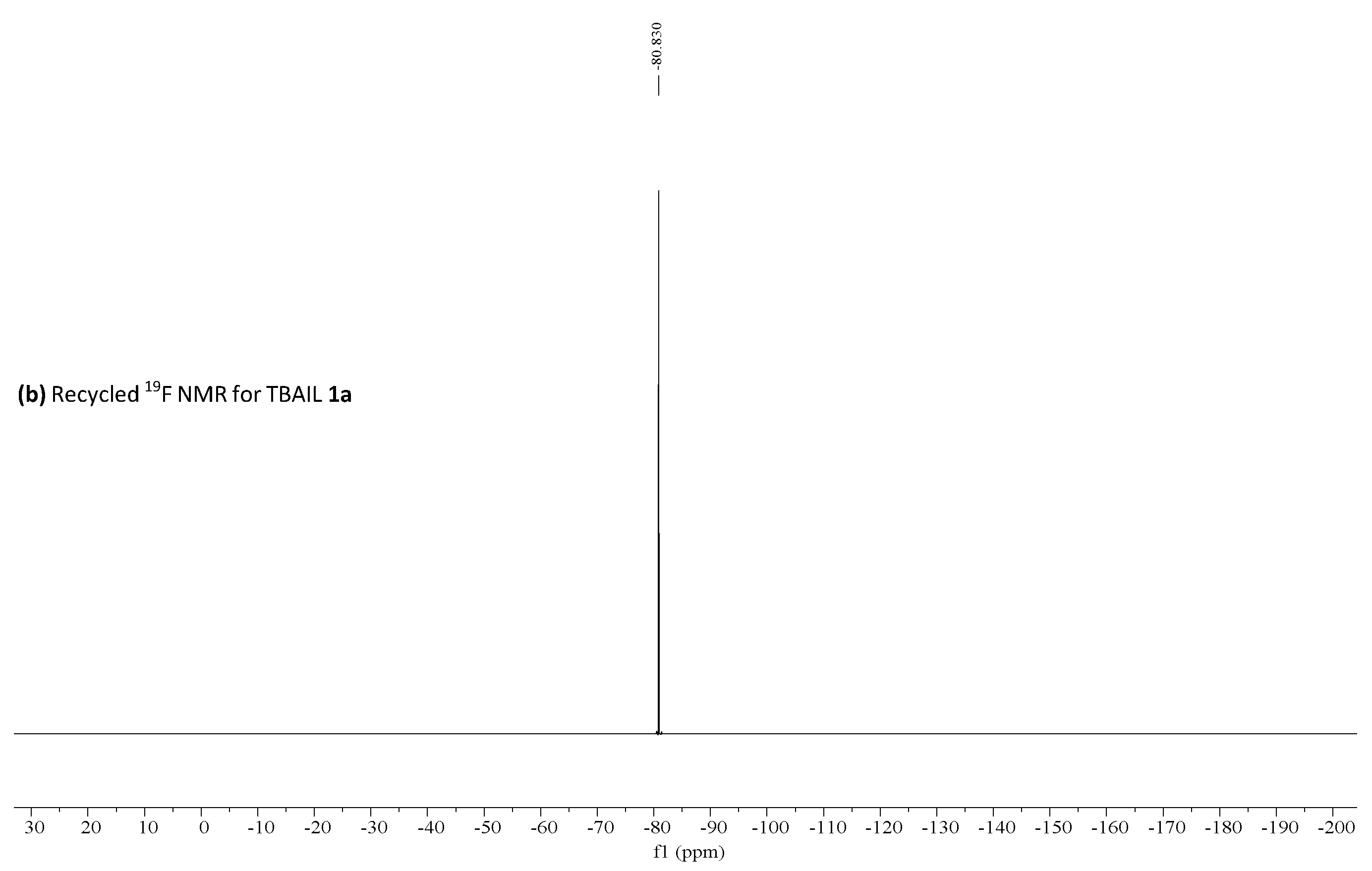Mild and Efficient Tunable Brønsted Acidic Ionic Liquid Catalyzed O-Acetylation and O-Trimethylsilylation with Trimethylsilyl Acetate (TMSOAc) and Hexamethyldisilazane (HMDS)
Abstract
:1. Introduction
2. Results and Discussion
2.1. Acetylation of Alcohols Using TMSOAc
2.2. Silylation of Alcohol Using HMDS
2.3. Reuse of TBAIL 1a for Silylation and Acetylation of Alcohols
3. Materials and Methods
3.1. General Information
3.2. General Procedure for Preparation of TBAILs
3.3. General Procedure for O-Acetylation Reaction (A)
3.4. General Procedure for O-Trimethylsilylation Reaction (B)
4. Conclusions
Supplementary Materials
Author Contributions
Funding
Data Availability Statement
Acknowledgments
Conflicts of Interest
References
- Wuts, P.G.M.; Greene, T.W. Greene’s Protective Groups in Organic Synthesis, 4th ed.; Wiley: Hoboken, NJ, USA, 2007; pp. 1–16. [Google Scholar]
- Sartori, G.; Ballini, R.; Bigi, F.; Bosica, G.; Maggi, R.; Righi, P. Protection (and deprotection) of functional groups in organic synthesis by heterogeneous catalysis. Chem. Rev. 2004, 104, 199–250. [Google Scholar] [CrossRef] [PubMed]
- Greene, T.W.; Wuts, M.G.P. Protective Groups in Organic Synthesis, 3rd ed.; Wiley: New York, NY, USA, 1999; pp. 1–52. [Google Scholar]
- Larock, C.R. Comprehensive Organic Transformations, 3rd ed.; VCH Publishers Inc.: New York, NY, USA, 1989. [Google Scholar]
- Ishihara, K.; Kubota, M.; Kurihara, H.; Yamamoto, H. Scandium trifluromethanesulfonate as an extrely active acylation catalyst. J. Am. Chem. Soc. 1995, 117, 4413–4414. [Google Scholar] [CrossRef]
- Ishihara, K.; Kubota, M.; Kurihara, H.; Yamamoto, H. Scandium trifluoromethanesulfonate as an extremely active Lewis acid catalyst in acylation of alcohols with acid anhydrides and mixed anhydrides. J. Org. Chem. 1996, 61, 4560–4567. [Google Scholar] [CrossRef]
- Procopiou, P.A.; Baugh, S.P.D.; Flack, S.S.; Inglis, G.G.A. An extremely powerful acylation reaction of alcohols with acid anhydrides catalyzed by trimethylsilyl trifluoromethanesulfonate. J. Org. Chem. 1998, 63, 2342–2347. [Google Scholar] [CrossRef]
- Procopiou, P.A.; Baugh, S.P.D.; Flack, S.S.; Inglis, G.G.A. An extremely fast and efficient acylation reaction of alcohols with acid anhydrides in the presence of trimethylsilyl trifluoromethanesulfonate as catalyst. Chem. Commun. 1996, 23, 2625–2626. [Google Scholar] [CrossRef]
- Carrigan, M.D.; Freiberg, D.; Smith, R.C.; Zerth, H.M.; Mohan, R.S. A simple and practical method for large-Scale acetylation of alcohols and diols using bismuth triflate. Synthesis 2001, 14, 2091–2094. [Google Scholar] [CrossRef]
- Chaubey, S.A.; Mishra, R. Synthesis of task-specifc imidazolium ionic liquid as an efcient catalyst in acetylation of alcohols, phenols, and amines. Chem. Pap. 2020, 74, 3259–3268. [Google Scholar] [CrossRef]
- Lee, S.G.; Park, J.H. Metallic Lewis acids-catalyzed acetylation of alcohols with acetic anhydride and acetic acid in ionic liquids: Study on reactivity and reusability of the catalysts. J. Mol. Catal. A Chem. 2003, 194, 49–52. [Google Scholar] [CrossRef]
- Qian, L.; Ji, C.; Chen, X.Z. Lewis basic ionic liquid as an efficient and facile catalyst for acetylation of alcohols, phenols, and amines under solvent-free conditions. Mon. Chem. Chem. Mon. 2013, 144, 369–374. [Google Scholar]
- Liu, Y.; Liu, L.; Lu, Y.; Cai, Y.Q. An imidazolium tosylate salt as efficient and recyclable catalyst for acetylation in an ionic liquid. Mon. Chem. Chem. Mon. 2008, 139, 633–638. [Google Scholar] [CrossRef]
- Yurev, Y.K.; Belyakova, Z.V. Acyloxysilanes. Russ. Chem. Rev. 1960, 29, 383–394. [Google Scholar] [CrossRef]
- Gilman, H.; Smart, G.N.R. Steric hindrances in highly-substituted organosilicon compounds. III. The preparation and properties of some triaryl silyl ethers. J. Org. Chem. 1954, 19, 441–450. [Google Scholar] [CrossRef]
- Sommer, L.H.; Parker, G.A.; Frye, C.L. Stereochemistry of asymmetric silicon. III. carboxylate and tosylate leaving groups. J. Am. Chem. Soc. 1964, 86, 3280–3283. [Google Scholar] [CrossRef]
- Gornowicz, A.G.; West, R. Lithiation of trimethylsilyl compounds. J. Am. Chem. Soc. 1968, 90, 4478–4479. [Google Scholar] [CrossRef]
- Anderson, H.H.; Fischer, H. Methylsilicon esters. Esters in an organosilicon “Conversion series”. J. Org. Chem. 1954, 19, 1296–1299. [Google Scholar] [CrossRef]
- Olah, G.A.; Narang, C.S.; Salem, F.G.; Gupta, B.G.B. Synthetic methods and reactions. Iodotrimethylsilane mediated mild and neutral transesterification of esters. Synthesis 1981, 2, 142–143. [Google Scholar] [CrossRef]
- Matsumoto, K.; Sajna, K.V.; Satoh, Y.; Sato, K.; Shimada, S. By-product free siloxane bond formation and one pot oligosiloxane synthesis. Angew. Chem. Int. Ed. 2017, 129, 3216–3219. [Google Scholar] [CrossRef]
- Rakovshik, A.; Shtelman, A.V.; Becker, J.Y. Synthesis of α-germyl and α-silylcarboxylic acids and selected electrochemical oxidations. J. Organomet. Chem. 2012, 706–709, 13–19. [Google Scholar] [CrossRef]
- Bellassoued, M.; Mouelhi, S.; Fromentin, P.; Gonzalez, A. Two-carbon homologation of ketones via sily ketene acetals: Synthesis of α, β-unsaturated acids and a trimethylsilyl δ-ketoacids. J. Organomet. Chem. 2005, 690, 2172–2179. [Google Scholar] [CrossRef]
- Chen, J.S.; Ke, Y.F.; Lin, H.Y.; Lin, W.; Yen, W.C.; Wud, H.R.; Luo, S.Y. Development of a novel method for trimethylsilylation of saccharides. Synthesis 2021, 53, 2000–2006. [Google Scholar] [CrossRef]
- Langer, S.H.; Connell, S.; Wender, J. Preparation and properties of trimethylsilyl ethers and related compounds. J. Org. Chem. 1958, 23, 50–58. [Google Scholar] [CrossRef]
- Gauuret, P.; El-Ghamarli, S.; Legrand, A.; Couirier, D.; Rigo, B. On the silylation of diarylcarbinols. Synth. Commun. 1996, 26, 707–713. [Google Scholar] [CrossRef]
- Morita, T.; Okamoto, Y.; Sakurai, H. Use of allyl silanes as a new type of silylating agent for alcohols and carboxylic acids. Tetrahedron Lett. 1980, 21, 835–838. [Google Scholar] [CrossRef]
- Azizi, N.; Yousefi, R.; Saidi, M.R. Efficient and practical protocol for silylation of hydroxylgroups using reusable lithium perchlorate dispreadin silica gel under neutral condition. J. Organometal. Chem. 2006, 691, 817–820. [Google Scholar] [CrossRef]
- Zadehahmadi, F.; Tangestaninejad, S.; Moghadam, M.; Mirkhani, V.; Baltork, I.M.; Kardanpour, R. Highly efficient protection of alcohols and phenols catalysed by tin porphyrin supported on MIL-101. Appl. Organometal. Chem. 2015, 29, 209–215. [Google Scholar] [CrossRef]
- Gharaati, S.; Moghadam, M.; Tangestaninejad, S.; Mirkhani, V.; Baltork, I.M. Highly efficient and selective trimethylsilylation of alcohols and phenols with hexamethyldisilazane catalyzed by polystyrene-bound tin (IV) porphyrin. Polyhedron 2012, 35, 87–95. [Google Scholar] [CrossRef]
- Boerner, D.; Koerner, G.; Spieker, F.; Wiemann, M. Verfahren zur Silylierung. German Patent DE2757936, 21 September 1978. [Google Scholar]
- Zhang, Z.H.; Li, T.S.; Yang, F.; Fu, C.G. Montmorillonite clay catalysis XI: Protection and deprotection of hydroxyl group by formation and cleavage of trimethylsilyl ethers catalysed by montmorillonite K-10. Synth. Commun. 1998, 28, 3105–3114. [Google Scholar] [CrossRef]
- Firouzabadi, H.; Karimi, B. Zinc chloride catalyzed silylation of alcohols and phenols by hexamethyldisilazane. A highly chemoselective reaction. Synth. Commun. 1993, 23, 1633–1641. [Google Scholar] [CrossRef]
- Firouzabadi, H.; Sardarian, A.R.; Khayat, Z.; Karimi, B.; Tangestaninejad, S. Nitrogen ligand complexes of metal chlorides as effective catalysts for the highly regioand chemoselective silylation of hydroxyl groups with hexamethyldisilazane (HMDS) at room temperature. Synth. Commun. 1997, 27, 2709–2719. [Google Scholar] [CrossRef]
- Karimi, B.; Golshani, B. Mild and highly efficient method for the silylation of alcohols using hexamethyldisilazane catalyzed by iodine under nearly neutral reaction conditions. J. Org. Chem. 2000, 65, 7228–7230. [Google Scholar] [CrossRef] [PubMed]
- Firouzabadi, H.; Iranpoor, N.; Amani, K.; Nowrouzi, F. Tungstophosphoric acid (H3PW12O40) as a heterogeneous inorganic catalyst. Activation of hexamethyldisilazane (HMDS) by tungstophosphoric acid for efficient and selective solvent-free O-silylation reactions. J. Chem. Soc. Perkin Trans. 2002, 1, 2601–2604. [Google Scholar] [CrossRef]
- Shirini, F.; Atghia, S.V.; Jirdehi, M.G. Nanocrystalline TiO2-HClO4 as a new, efficient and recyclable catalyst for the chemoselective trimethylsilylation of alcohols, phenols and deprotection of silyl ethers. Catal. Commun. 2012, 18, 5–10. [Google Scholar] [CrossRef]
- Moghadam, M.; Tangestaninejad, S.; Mirkhani, V.; Baltork, M.I.; Chahardahcheric, S.; Tavakoli, Z. Rapid and highly efficient trimethylsilylation of alcohols and phenols with hexamethyldisilazane (HMDS) catalyzed by reusable zirconyl triflate, [ZrO(OTf)2]. Organomet. Chem. 2008, 693, 2041–2046. [Google Scholar] [CrossRef]
- Firouzabadi, H.; Iranpoor, N.; Farahi, S. Highly regio- and chemoselective silylation of diethyla-hydroxyphosphonates, alcohols and phenols in the presence of solid TiCl3(OTf) as a catalyst with hexamethyldisilazane (HMDS) at room temperature in the absence of solvent. Catal. Commun. 2009, 10, 1547–1550. [Google Scholar] [CrossRef]
- Villabrille, P.; Romanelli, G.; Quaranta, N.; Vázquez, P. An efficient catalytic route for the preparation of silyl ethers usingalumina-supported heteropolyoxometalates. Appl. Catal. B 2010, 96, 379–386. [Google Scholar] [CrossRef]
- Sridhar, M.; Raveendra, J.; Ramanaiah, B.C.; Narsaiah, C. An efficient synthesis of silyl ethers of primary alcohols, secondary alcohols, phenols and oximes with a hydrosilane using InBr3 as a catalyst. Tetrahedron Lett. 2011, 52, 5980–5982. [Google Scholar] [CrossRef]
- Shirini, F.; Khaligh, G.N.; Dadamahaleh, S.A. Preparation, characterization and use of 1,3-disulfonic acid imidazolium hydrogen sulfate as an efficient, halogen-free and reusable ionic liquid catalyst for the trimethylsilyl protection of hydroxyl groups and deprotection of the obtained trimethylsilanes. J. Mol. Catal. A Chem. 2012, 365, 15–23. [Google Scholar]
- Shirini, F.; Mollarazi, E. Efficient trimethylsilylation of alcohols and phenols in the presence of ZrCl4 as a reusable catalyst. Catal. Commun. 2007, 8, 1393–1396. [Google Scholar] [CrossRef]
- Dhakshinamoorthy, A.; Portillo, A.S.; Concepción, P.; Herance, R.J.; Navalón, S.; Alvaro, P.; Garcia, H. Room temperature silylation of alcohols catalyzed by metal organic frameworks. Catal. Sci. Technol. 2017, 7, 2445–2449. [Google Scholar] [CrossRef]
- Anbu, N.; Vijayan, C.; Dhakshinamoorthy, A. A simple and efficient room temperature silylation of diverse functional groups with hexamethyldisilazane using CeO2 nanoparticles as solid catalysts. Mol. Catal. 2019, 474, 110357. [Google Scholar] [CrossRef]
- Ko, Y.C.; Tsai, C.F.; Wang, C.C.; Dhurandhare, V.M.; Hu, L.P.; Su, T.Y.; Lico, L.S.; Zulueta, M.M.L.; Hung, S.C. Microwave-assisted one-pot synthesis of 1,6-anhydrosugars and orthogonally protected thioglycosides. J. Am. Chem. Soc. 2014, 136, 14425–14431. [Google Scholar] [CrossRef] [PubMed]
- Joseph, A.A.; Dhurandhare, V.M.; Chang, C.W.; Verma, V.P.; Mishra, G.P.; Ku, C.C.; Lin, C.C.; Wang, C.C. Chemoselective per-O-trimethylsilylation and homogeneous N-functionalisation of amino sugars. Chem. Commun. 2015, 51, 104. [Google Scholar] [CrossRef] [PubMed]
- Abbasi, F.; Azizi, N.; Senejani, M.A. Chlorozincate (II) acidic ionic liquid: Efficient and biodegradable silylation catalyst. Appl. Organomet. Chem. 2017, 31, e3790. [Google Scholar] [CrossRef]
- Tajik, H.; Niknama, K.; Karimian, S. Silylation of alcohols and phenols by HMDS in the presence of ionic liquid and silica-supported ionic liquids. Iran. J. Catal. 2013, 3, 107–113. [Google Scholar]
- Ahrens, S.; Peritz, A.; Strassner, T. Tunable aryl alkyl ionic liquids (TAAILs): The next generation of ionic liquids. Angew. Chem. Int. Ed. 2009, 48, 7908–7910. [Google Scholar] [CrossRef]
- Cole, A.C.; Jensen, L.J.; Ntai, I.; Tran, K.L.T.; Weaver, K.J.; Forbes, D.C.; Davis, J.H. Novel Brønsted acidic ionic liquids and their use as dual solvent-catalysts. J. Am. Chem. Soc. 2002, 124, 5962–5963. [Google Scholar] [CrossRef]
- Li, C.; Wang, M.; Lu, X.; Zhang, L.; Jiang, J.; Zhang, L. Reusable Brønsted acidic ionic liquid efficiently catalyzed N-formylation and N-acylation of amines. ACS Sustain. Chem. Eng. 2020, 8, 4353–4361. [Google Scholar] [CrossRef]
- Lin, Y.J.; Wu, Y.P.; Thul, M.; Hung, M.W.; Chou, S.H.; Chen, W.T.; Lin, W.; Lin, M.; Reddy, D.M.; Wu, H.R.; et al. Tunable aryl imidazolium recyclable ionic liquid with dual Brønsted-Lewis acid as green catalyst for Friedel-Crafts acylation and thioesterification. Molecules 2020, 25, 352. [Google Scholar] [CrossRef] [PubMed] [Green Version]
- Thul, M.; Wu, P.Y.; Lin, Y.J.; Du, S.L.; Wu, H.R.; Ho, W.Y.; Luo, S.Y. Ionic iquid catalyzed per-O-acetylation and benzylidene ring-opening reaction. Catalysts 2020, 10, 642. [Google Scholar] [CrossRef]
- Thul, M.; Pantawane, A.; Lin, W.; Lin, Y.J.; Po, P.F.; Tseng, S.A.; Wu, H.R.; Ho, W.Y.; Luo, S.Y. Tunable aryl imidazolium ionic liquids (TAIILs) as environmentally benign catalysts for the esterification of fatty acids to biodiesel fuel. Catal. Commun. 2021, 149, 106243. [Google Scholar] [CrossRef]
- Orita, A.; Mitsutome, A.; Otera, J. Distannoxane-catalyzed highly selective acylation of alcohols. J. Org. Chem. 1998, 63, 2420–2421. [Google Scholar] [CrossRef] [PubMed]








| Entry | Ionic Liquid (equiv.) | TMSOAc (equiv.) | Time (h) | Yield (%) b |
|---|---|---|---|---|
| 1. | 1a (0.05) | 2.0 | 4 | 95% |
| 2. | 1b (0.05) | 2.0 | 24 | 51% |
| 3. | 1c (0.05) | 2.0 | 24 | 0% |
| 4. | 1d (0.05) | 2.0 | 24 | 85% |
| 5. | 1e (0.05) | 2.0 | 24 | 15% |
| 6. | 1f (0.05) | 2.0 | 24 | 65% |
| 7. | 1a (0.03) | 2.0 | 4 | 75% |
| 8. | 1a (0.07) | 2.0 | 4 | 95% |
| 9. | 1a (0.05) | 1.5 | 4 | 88% |
| 10. | 1a (0.05) | 2.5 | 4 | 95% |
| Entry | Catalyst | Solvent | Acylating Agent | T (℃) | Reuse Cycles | Ref. |
|---|---|---|---|---|---|---|
| 1 | [Boc-NH-EMIM][OAc] | - | Ac2O | rt | 5 | [10] |
| 2 | Metallic Lewis acids | [bmim][PF6] | AcOH/Ac2O | 20 | - | [11] |
| 3 | [HDBU]OAc | - | Ac2O | 50 | 5 | [12] |
| 4 | ([bmim][OTs]) | ([bmim][BF4]) | Ac2O | 50 | - | [13] |
| 5 | TBAIL (1a) | - | TMSOAc | rt | 5 | Present work |

| Entry | Ionic Liquid (equiv.) | HMDS (equiv.) | Time (h) | Yield (%) b |
|---|---|---|---|---|
| 1. | no catalyst | 1.2 | 96 | 45% |
| 2. | 1a (0.05) | 1.0 | 1 | 98% |
| 3. | 1b (0.05) | 1.0 | 4 | 88% |
| 4. | 1c (0.05) | 1.0 | 2 | 90% |
| 5. | 1d (0.05) | 1.0 | 1.5 | 91% |
| 6. | 1e (0.05) | 1.0 | 1 | 87% |
| 7. | 1f (0.05) | 1.0 | 12 | 90% |
| 8. | 1a (0.03) | 1.0 | 1 | 93% |
| 9. | 1a (0.07) | 1.0 | 1 | 92% |
Publisher’s Note: MDPI stays neutral with regard to jurisdictional claims in published maps and institutional affiliations. |
© 2021 by the authors. Licensee MDPI, Basel, Switzerland. This article is an open access article distributed under the terms and conditions of the Creative Commons Attribution (CC BY) license (https://creativecommons.org/licenses/by/4.0/).
Share and Cite
Pantawane, A.R.; Thul, M.; Lin, Y.-J.; Lin, M.; Lin, W.; Julakanti, S.R.; Wu, H.-R.; Luo, S.-Y. Mild and Efficient Tunable Brønsted Acidic Ionic Liquid Catalyzed O-Acetylation and O-Trimethylsilylation with Trimethylsilyl Acetate (TMSOAc) and Hexamethyldisilazane (HMDS). Catalysts 2021, 11, 825. https://doi.org/10.3390/catal11070825
Pantawane AR, Thul M, Lin Y-J, Lin M, Lin W, Julakanti SR, Wu H-R, Luo S-Y. Mild and Efficient Tunable Brønsted Acidic Ionic Liquid Catalyzed O-Acetylation and O-Trimethylsilylation with Trimethylsilyl Acetate (TMSOAc) and Hexamethyldisilazane (HMDS). Catalysts. 2021; 11(7):825. https://doi.org/10.3390/catal11070825
Chicago/Turabian StylePantawane, Amit Ravindra, Mayur Thul, Yi-Jyun Lin, Michelle Lin, Wesley Lin, Satyanarayana Reddy Julakanti, Hsin-Ru Wu, and Shun-Yuan Luo. 2021. "Mild and Efficient Tunable Brønsted Acidic Ionic Liquid Catalyzed O-Acetylation and O-Trimethylsilylation with Trimethylsilyl Acetate (TMSOAc) and Hexamethyldisilazane (HMDS)" Catalysts 11, no. 7: 825. https://doi.org/10.3390/catal11070825
APA StylePantawane, A. R., Thul, M., Lin, Y.-J., Lin, M., Lin, W., Julakanti, S. R., Wu, H.-R., & Luo, S.-Y. (2021). Mild and Efficient Tunable Brønsted Acidic Ionic Liquid Catalyzed O-Acetylation and O-Trimethylsilylation with Trimethylsilyl Acetate (TMSOAc) and Hexamethyldisilazane (HMDS). Catalysts, 11(7), 825. https://doi.org/10.3390/catal11070825








